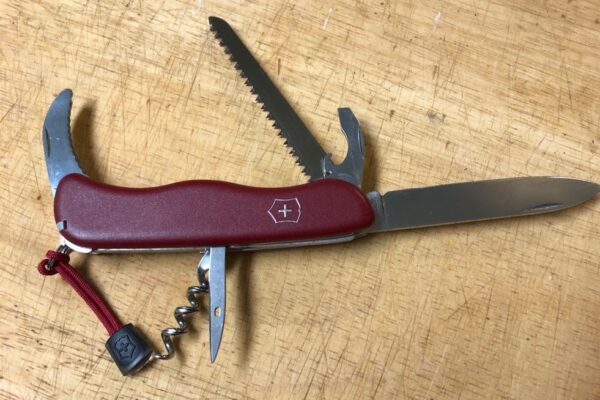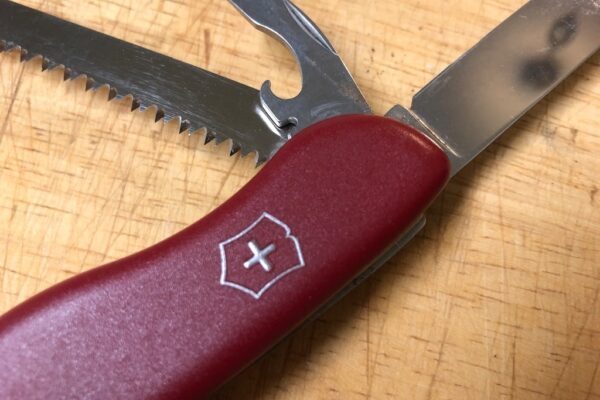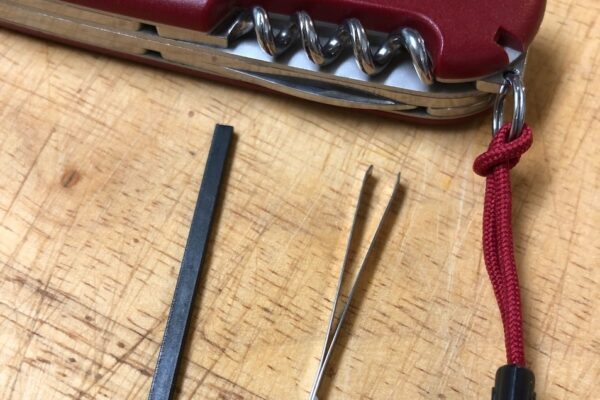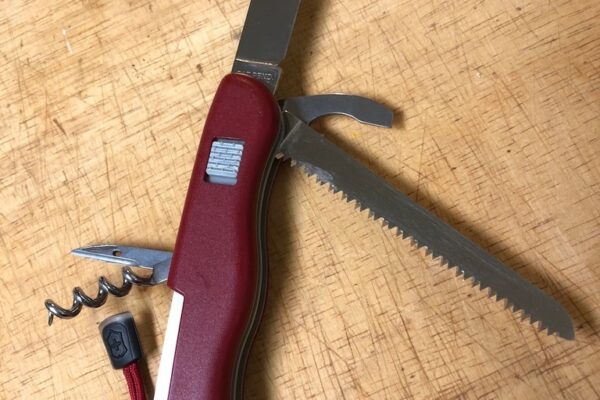By Martin Malacara
Yes, the Swiss make hunting knives, too!
For thousands of years, humans have used some sort of cutting tool to make their lives a bit easier. Early cutting devices crafted from sharpened or knapped stones have been used to cut through animal hides and meat to provide much needed sustenance; to cut and shape material to make clothing, and for creating other tools from animal bones.
Eventually, humans learned the art of forging metal, taking it from the earth and smelting it to fashion into useful tools and weapons, such as knives. Knives are used all over the world and have become highly sought-after collectibles and status symbols.
Early folks appreciated the value of a good knife or tool, but they could only carry so many of them from place to place. Somewhere along humanity’s timeline, someone thought about creating an all-in-one tool, which could easily fit inside a pouch or pocket. An unknown Roman did just that, and created the world’s first specialty knife, or “multi-tool.”
The Fitzwilliam Museum at the University of Cambridge in the United Kingdom displays one of these tools, possibly left behind by a Roman soldier on one of many military campaigns. The folding tool, made from silver and iron, features a knife, spoon, three-pronged fork, pick and spike.
Emergence of Swiss knife tech
After the fall of the Roman Empire, the Dark Ages swept across the Old World, and shut down any advancement in technology, including the development of the Roman multi-tool. Such a tool wouldn’t resurface until the late 19th century. Enter Swiss entrepreneur Karl Elsener.
Karl Elsener started his own company in 1884, making medical instruments and knives. Later, he realized that he could take a “stab” at making specialty knives for the Swiss Army. According to company history, his factory—originating in Ibach, Switzerland—produced the first Swiss Army knife in 1891. Elsener’s company, which later became Victorinox, won the contract to produce the Swiss Army’s Modell 1890 knife from the previous German manufacturer, Wester & Co. of Solingen. The knife had a blade, reamer, can opener, screwdriver, and grips made out of dark oak wood, that some say was later partly replaced with ebony wood. The many tools come standard on today’s knives.
In 1893, a rival Swiss cutlery company, Paul Boéchat & Cie, which later became Wenger SA, received its first contract from the Swiss military to produce model 1890 knives. The two companies split the contract for knives from 1908 until Victorinox acquired Wenger—pronounced “Venger”—in 2005.
Elsener renamed his company in 1911 after his mother, Victoria, who supported him throughout his endeavors. Elsener’s son Carl took over the company in 1918 after his father’s death, and renamed it in 1921 to “Victorinox,” incorporating the abbreviation “inox” for acier inoxydable, the French term for stainless steel, which they started using that year.
Birth of an icon
Giving birth to a cultural icon of Switzerland, the company’s knife design and its versatility earned worldwide recognition. Victorinox managed to survive during the second World War, and afterwards in 1945, the company’s fortune and brand name began to bloom, by way of U.S. soldiers stationed in Europe purchasing the knives as souvenirs, thereby introducing the knife to a whole new market.
Today, you can find a Victorinox knife at most of the big-box stores, hunting and sporting goods shops, and of course, Amazon. If you do a little hunting online at eBay and other online retailers, you can find older models and custom knives with different grips.
I collect and use Victorinox knives. A particular model I own, dubbed “The Hunter,” is one that even television’s prolific Victorinox knife-user, MacGyver, never used in the series to defuse a nuclear bomb or pick a lock.
Swiss Army “Hunter”
The Hunter model features a 111mm slide-locking Victorinox Swiss Army knife blade. This model, from the mid 1980s, includes a small, curved gutting blade with a serrated edge, as well as the 111mm version of the Combo Tool (can/bottle opener/screwdriver/wire stripper), a sawblade, corkscrew, reamer with sewing-eye, with toothpick and tweezers stored inside the grips. The gutting blade and the Combo Tool weren’t very common at the time. Given that this model loses the regular opener layer, it’s quite light-weight for its capabilities, particularly the slide-lock version, according to online Swiss Army knife encyclopedia SAKWiki.com. The Hunter has been available with various different scale (grip) options—red, green, and camouflage—also a Phillips screwdriver variation. The original version of this model was slide-locking.
In 2017 Victorinox completely revised their 111mm product line and ceased production of slide-lock models. The Hunter was converted to be liner-locking as part of that change. Newer Hunter models come with wood or aluminum grips in different colors.
Handy Swiss EDC (every day carry)
I’ve carried my Hunter while hiking in the Hill Country surrounding San Antonio; along the banks of the Guadalupe River and at Pedernales Falls; from the Texas Coast to Palo Duro Canyon; to the Guadalupe Mountains and Chisos Mountains, with a side trip to Fort Stockton and sleeping under the stars in Seminole Canyon. The only places I haven’t carried it are East Texas and the Rio Grande Valley—but they’re next on my hiking list.
I’ve used the knife to cut fish, fishing line, rope, apples and sandwiches. I’ve used the corkscrew to open some rather savory Texas wine. I’ve used the sawblade to cut twigs and small branches for starting campfires and I’ve used the tweezers for pulling nasty stickers off my shoes and socks. I’ve also used the screwdriver to open the battery compartment on my Pentax “prosumer” digital camera to swap out the batteries, and to unscrew the camera’s bottom from my tripod. And I’m more than sure it’ll get the job done on any game animal.
Victorinox might not be a brand that comes to mind when you think about hunting knives, but you’ll definitely be surprised by its usefulness and versatility. It’s a good companion to have inside a deer blind or in the field. Besides, who wouldn’t want a knife that can do so much more?






